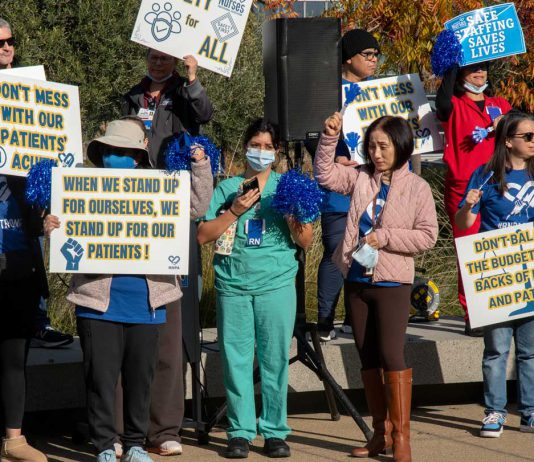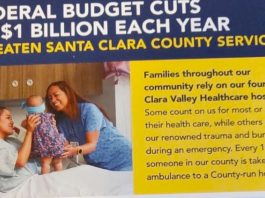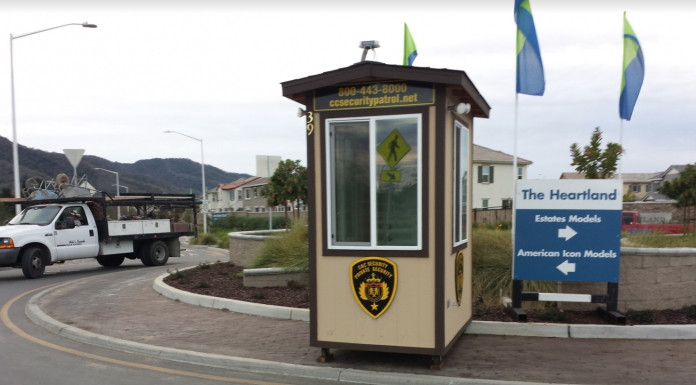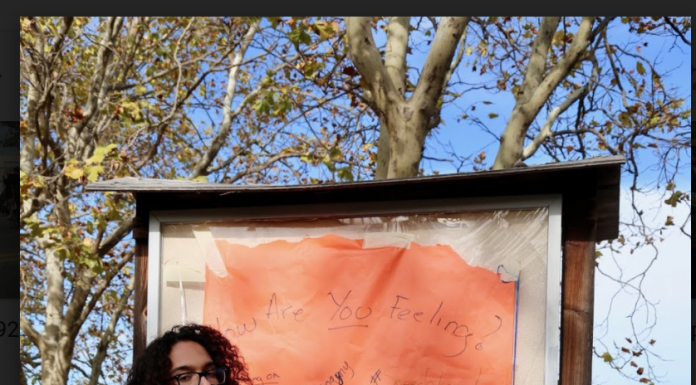Gilroy Gets New Stripes
Gilroy’s growing so fast, and the need has become so complex, that the city has contracted for the first time with a company that specializes in striping streets, roundabouts, biking trails and other transportation pathways.
Inclement Weather Alert for South County Homeless
An Important Press Release: In response to the National Weather Service forecast of temperatures dropping into the 30s in some areas, the County of Santa Clara Office of Supportive Housing is declaring an Inclement Weather Episode for South County ONLY (Morgan Hill, San Martin and Gilroy) starting Monday, November 28, and extending at least until through Saturday night, December 3, 2016. The Office of Supportive Housing can expand its shelter capacity and open early for inclement weather when there is a forecasted overnight low of 38 degrees or lower with a probability of rain less than 50 percent; or there is a forecasted overnight low of 42 degrees or lower with a probability of rain of 50 percent or greater. “We are doing everything we can to ensure families and individuals without a roof over their heads can be spared from the extremely cold temperatures expected this week, and are able to spend the night in a warm, safe place,” said Supervisor Mike Wasserman, District 1. “Our goal is to find permanent housing solutions, but we need to focus on the immediate needs of our homeless population.” The Gilroy Compassion Center (370 Tomkins Ct. just off of Murray Avenue, in Gilroy), will be available as a Warming Center according to its usual hours: 8:00 a.m. until noon. The Gilroy Armory will begin operations and be available for overnight shelter starting the evening of Wednesday, November 30th. Once it opens, its capacity will increase by 50 beds during Inclement Weather Episodes, which will be available on a first-come, first-served basis. This is an exception to the usual capacity of 130 beds, which are available by referral only—starting on the 30th. Each year, the County of Santa Clara’s Cold Weather Shelter Program (CWSP) provides homeless individual and families with a respite from cold and inclement weather from the Monday after Thanksgiving through March 31, with up to 395 additional beds offered at shelter locations. Beginning Nov. 28, the program will offer 125 beds at the North County Winter Shelter in Sunnyvale, and from November 30, 130 shelter beds will be available at the Gilroy Armory. Additionally, the County has expanded its program this year to offer shelter to 35 homeless families at the Arturo Ochoa Migrant Center in Gilroy. The new Ochoa Winter Family Shelter located at Arturo Ochoa Migrant Center in Gilroy will offer shelter to 35 homeless families, and up to 140 additional beds. The center, located on Southside Road, will provide intensive case management services to all the families, enabling them to receive the appropriate assistance they need to make the transition to stable housing. For homeless families seeking shelter in the Gilroy area, they can call St. Joseph’s Family Center for a referral at 408-842-6662, ext. 21. The Gilroy Armory Shelter and the Sunnyvale Shelter will provide warm beds, two nutritious meals a day, and a hot shower to clients. A variety of supportive services will also be offered, including guidance to help set short-term goals, employment resources, medical care, and referrals to other services. Volunteers provide haircuts and donated toiletries and clothing are available to those who need them. Both County shelters will be operated on a referral basis, working closely with HomeFirst to identify individuals/families who will be referred to the shelters to have a guaranteed bed throughout the CWSP period. HomeFirst will coordinate referrals for both sites. For individuals seeking shelter at the Gilroy Armory, call 408-489-8781 or for the Sunnyvale Shelter, call 408-854-4670. “It is our priority to find additional beds and warming centers during extreme and inclement weather for homeless adults and families,” said Bob Dolci, Housing and Homeless Concerns Coordinator with the Santa Clara County Office of Supportive Housing.
Guard Shack Controversy
Fed up with early morning noise and traffic from ongoing construction, residents of one of Gilroy’s newest high-end subdivisions woke up to a new neighbor this week.It’s a manned guard shack that showed up in the middle of the roundabout at the entrance to Meritage Homes’ Heartland housing development.It’s designed to control the flow of construction-related traffic and keep noise levels down in the before-dawn hours.But a city official Tuesday said it must be moved.“I understand why they did this but it’s not in a safe location, so we will ask the developer to move this to a safer spot until they finish construction activities, Rick Smelser said in an email. He is Gilroy’s director of public works and city engineer.The playhouse-size structure was set up on city property, the roundabout island at the corner of West Third Street and Cobblestone Court, just west of Santa Teresa Boulevard and the Village Green senior housing community.A spokesman for C&C Security said Meritage requested the manned booth after receiving complaints from new residents of the $870,000 to $943,000 homes.They’ve complained about pre-dawn noise and traffic from contractors building more new homes in developments that stretch roughly along Hecker Pass Highway west from Santa Teresa to Burchell Road.Chapter 16, section 31 of the city code prohibits loud noise of any kind that disturbs another person in their home between the hours of 10 p.m. and 7 a.m. Wayne Spalding, vice president of human resources for the Fremont-based C&C Security, said a uniformed guard arrives early in the morning to make sure no one begins work before 7 a.m.The guard then patrols the neighborhood and construction areas from a vehicle, he said.The project’s new construction manager requested that the guard shack be placed on the roundabout island, according to Spalding.An early morning observer to the area would witness not only the arrival of construction workers, but also large and small trucks loaded with everything from pre-fabricated housing rafters to roofing materials and landscaping equipment and plants.The long, new stretch of W 3rd Street, with at least one elementary school bus stop, also has become the scene of high-speed driving, the almost universal running of the stop sign at Rosemary Drive by residents, construction workers and truck drivers, and numerous incidents of cars and trucks going the wrong way at the roundabout—some trucks doing so because they are too long to negotiate the sharp curves of the roundabout.At the Gilroy Police Department, Capt. Kurt Svardal said the guard shack arrangement between the private security firm and the development company does not involve police, although he said he was “a little surprised” by the location of the structure on the roundabout.Smelser said that while he was unaware of the guard shack until asked about it Tuesday by the Dispatch, builders are legally allowed to take steps to secure their projects and equipment even if it involves city property.“During construction, before the city has fully accepted the construction, the contractor has every right to protect their equipment,” he said.As for traffic and noise associated with building activities, he said, “They have every right to control what is going on during construction; if they want to control construction activity, I can see that,” Smelser added.A spokesperson for the Meritage did not return phone calls seeking comment.
Dozens March for Unity in Gilroy Thursday
More than 50 students, parents and members of the community marched nearly two miles through Gilroy to City Hall Thursday at noon to celebrate unity and diversity, things they said were absent in the campaign rhetoric of President-elect Donald J. Trump.The march, organized by the Student Democratic Club at Gavilan College and including local middle and high school students, started at the old CVS store on First Street and continued along Hanna to City Hall, where the peaceful gathering concluded with speakers and a sharing circle on the complex lawn. As they marched they chanted “Unity through diversity,” “The people united will never be divided” “Hey Ho Racism has got to go.” Noshava Afzao, a Gilroy educational consultant who trains teachers, and wore a hijab said she was there with a flag to accent that liberty and justice “was for everyone.” She worried about how the election would affect that. “There’s a lot of disappointment,” she said. “The election is a wake up call. I thought we lived in a country that had made progress and this just shows how much progress we need to make.”As word spread that students at Gavilan College were planning a citywide walkout, school administrators scrambled to inform high school parents.“Gilroy is a lovely little bubble of people who are not always proactive. We want to acknowledge voices and create a coalition,” said Sarah Najar, Vice President of the Gavilan Democratic Club.An email to Christopher High School parents from Principal Paul Winslow said: “FYI High School Parents: Someone is encouraging students to cut school” and “while we definitely support free speech, the right to assemble peacefully, and the right to express opinion” students who missed school to participate would be penalized and not be able to make up work.Lisa Ruiz, a parent of Gilroy students with special needs, said she received a call from the GUSD the night before alerting her that any absence would be considered unexcused, but felt she needed to come anyways.“I got to be here in solidarity with the minorities in the community and to see what we can do to help to unify everyone not be divided and hopefully we can get together in love.”As people gathered in the parking lot, members of the Gilroy Police Department kept an eye on proceedings. Sgt. Wes Stanford had a team of motorcycle officers charged with making sure the demonstrators were safe walking the mile and a half between First Street and City Hall. The department was notified of the march, but organizers didn’t know they would need a permit. “We want to make sure that it’s peaceful, that they are allowed to voice their opinion and whatever views they have and they get to City Hall in a safe fashion.” Stanford said the city has had sporadic marches over the years with the last one he remembers an Occupy Gilroy march of eight people.The well-behaved crowd began their march up First Street - along the sidewalks and stopping at all intersections, using the crosswalks - the sound of honking cars mingling with chants calling for unity.Iris Cueto, 23, a Gavilan biology major, said “The election is making me feel sad, but it’s also making me feel happy to have youth standing up for their rights. It’s nice to see them out here protesting in a peaceful way.” Holding up a coat hanger poster that read, “Never Again,” Summer Diaz, 18, said: “I believe everyone should have their rights. I believe that women should make their own choice and politicians should stay out of women’s rights. “ When the marchers got to City Hall they were offered bottled water by the student organizers who then thanked the crowd for obeying all the traffic laws and the police for “keeping us safe.” Addressing the group, Dr. Enrique Luna, who teaches history at Gavilan, said “we don’t want to be here, but there is a need.” Thanking the march organizers for putting on the event, he said at times he was both laughing and shedding a few tears during the march to city hall. It’s hard to build a community, it’s easy to destroy a community. And we are here to do the hard work.”
Bye-bye, plastic bags
No longer an oasis of polyethylene in Santa Clara County, Gilroy joined the rest of the state in getting rid of single-use plastic bags, as California voted to ban the environmental hazard on Nov. 8, the first state in the nation to do so.Proposition 67, which put plastic shopping bags on the chopping block, was passed 52 to 48 percent and created a unified law for the state, which saw an increasing number of local jurisdictions take up the issue since San Francisco became the first city in California to ban plastic bags in 2007.“It’s for the environment, no plastic bags is okay with me; I can carry my stuff,” said Gilroy resident, Kaylee Amaro, who was seen carrying her shopping, a package of cookies, outside Safeway on Friday.Effective immediately, the plastic bag ban restricts food retailers, corner markets and grocery stores from providing single-use plastic bags. Recyclable paper bags can be bought for 10 cents each. The money collected is kept by the retailer. A competing measure, Prop. 65, would have directed the fees to be used for environmental activities, but it did not pass.Before last week’s vote settled the matter in California, 122 ordinances banning single-use plastic bags had been approved in the state, covering 151 county or local jurisdictions, according to Ballotpedia. That is nearly half of California.In Gilroy, a single-use plastic bag ban was discussed by the City Council, first in 2008 to support the Cities Association of Santa Clara County and again a few years later, but the council took no action.In April, Councilwoman Cat Tucker reintroduced the issue at a policy meeting, but it was not pursued by the council.Now, Tucker, who won re-election to the council on Nov. 8, said she had been expecting the proposition to pass.A poll in October showed 45 percent of likely California voters supported the ban, along with a wide swathe of businesses, unions and organizations. Prop.67 was also endorsed by Gov. Jerry Brown and local state Senator Bill Monning.“I am happy,” said Tucker. “I personally always bring cloth bags when I go grocery shopping.”The passage of Prop 67 ratified Senate Bill 270, banning plastic bags in the state, considered a landmark bill when Governor Jerry Brown signed it in 2014.The bill was shelved after a successful signature-gathering effort by American Progressive Bag Alliance, a lobby group for plastic bag manufacturers, stalled it in its tracks.The same group spent $6.14 million to fight Prop. 67, and despite raising almost double the amount raised by the Yes on 67 campaign, it failed to stop momentum to ban that had been building across the state.Now, shoppers in Gilroy will have to kick their plastic bag habit, just like others in Santa Clara County did in years past.Plastic bags were banned in unincorporated areas of the county, including San Martin, since 2012. Morgan Hill’s ban began on Earth Day (April 22) 2014. San Jose has been plastic bag free since 2011.Even though the writing has been on the wall for sometime now, the change caught some by surprise at the grocery store in the days after the election.“It’s hard when you have the two kids and are trying to carry everything,” said Noemi Santiago, as she left with her two young children and an armload of groceries from Safeway on First Street.The plastic bag ban will not just require a behavioral shift from Gilroy shoppers, but for some residents, a lifestyle shift as well.“I like the plastic bags because you can throw garbage in them and tie them up and throw them in the garbage can,” said Dotty, a Gilroy resident who did not want to give her last name.Exiting Safeway on Friday, Dotty’s shopping cart was filled with paper bags, but she said she will start bringing her reusables.“I have my own bags in the car, so I will start using those. I like a bag that you could wash. The ones they are selling for 25 cents are too flimsy.”And while Dotty will happily change her shopping habits, she did not vote for the proposition.“I can’t believe in this, I’m sorry, I just don’t. I didn’t vote for it,” she said. “And this global warming stuff—I don’t believe in that either. I mean, the world changes automatically. That’s the way God made it and it’s not because of me doing something. Even if it was, even if everybody in the United States didn’t use plastic bags, didn’t do this, didn’t do that, it isn’t going to do a darn thing because the other countries are not doing it. You think our air is going to be any cleaner than theirs? No. So it’s just another way to get our money.”According to the Center for Biological Diversity, there was more plastic manufactured in the first decade of the 21st century, than in all the years leading up to 2000, and single-use plastic bags have become a target for those concerned about the level of plastic pollution in the environment.Less than 5 percent of plastic bags are recycled in California, so the majority end up as litter or in landfills and they are not biodegradable. They are made from polyethylene, which takes up to 1,000 years to decompose.It is estimated that 100,000 marine mammals die each year because of plastic litter in the North Pacific, according to marine research organization Algalita. A recent report from UC-Davis found that marine birds are attracted to the smell of plastic and consume the shimmery material, mistaking it for food.
Students Plan Walkout for Thursday
Gavilan College students are joining protests across the country with a walkout set for Thursday. The campus Democratic Club is planning to have students leave campus at noon, meet at the parking lot of the new CVS on First Street and head to City Hall, where they will hear speakers.
PUBLIC NOTICE – CITY OF MORGAN HILL
NOTICE IS HEREBY GIVEN THAT THE PLANNING COMMISSION OF THE CITY OF MORGAN HILL WILL CONDUCT A PUBLIC HEARING ON THE FOLLOWING PROPOSAL(S) AT THE DATE, TIME AND LOCATION LISTED BELOW. ALL INTERESTED PERSONS ARE INVITED TO ATTEND THE HEARING AND PROVIDE COMMENTS.
Get Involved Now in Your City Government
Open seatsThis week you had a chance to vote for the people you want to run your city. Now you have a chance to get out and run things yourself.Gilroy has openings for people to serve on city boards, which make policies and recommendations to the City Council about how things should be in the city. For people interested in politics, it’s an excellent first step toward higher office. For people who just want to serve their community, it’s one of the most important things you can do. It’s also tremendously educational.Terms start in the new year and the deadline to apply is Dec. 12. Documents are available at the City of Gilroy website.Here are the openings:The Arts & Culture Commission has one opening on the seven-member board, which advises on all things to do with local art and performance. Meets the second Tuesday of each month at 5:30 p.m.The Bicycle Pedestrian Commission has two open seats for people to study and advise on matters of two-wheeled transportation. The five-member commission meets the fourth Tuesday of each month at 6 p.m.The Building Board of Appeals has two of five seats open on a commission that hears construction and building appeals. It meets as needed.Community and Neighborhood Revitalization Committee has three of seven open seats. It studies needs and strategies for making neighborhoods better. It meets the third Wednesday of each month at 6:45 p.m.Historic Heritage Committee has one of five seats available to work on preserving Gilroy’s history. It meets the third Wednesday of each month at 5:30 p.m.Housing Advisory Committee has four of nine seats open to study housing matters. It meets the second Wednesday of each month at 6 p.m.The Planning Commission has one of seven seats open. More than any body apart from the City Council, this one determines how Gilroy will look. It meets the first Thursday of each month at 6:30 p.m.The Library Commission deals with the library and meets the second Wednesday of each month at 7 p.m. It has two of five seats open.The Parks and Recreation Commission has two of seven openings to determine all things about parks and fun. It meets the third Tuesday of each month at 6 p.m.The Personnel Commission has one of five seats available to handle city staff matters. It meets the second Monday of the month at 5:30 p.m.The Physically Challenged Board of Appeals has two of five seats open. It deals with ways the community can help those who are physically challenged. It meets the second Tuesday of each month at 10 a.m.The Public Art Commission has two of seven openings to work on matters of public art. It meets the fourth Wednesday of the month at 5:30 p.m.Don’t just talk about what you want to see in the city: make it happen here.
Editorial: The Upside of the Election
It’s hard not to think that Gilroy and the state of California are in a different country than the one that swept in a strong Republican, anti-government agenda.Gilroyans took a hard liberal bent and chose to cut sprawling growth out of the city limits and focus on downtown development. It elected a slate of slow-growthers and tossed out those who tried to sneak by a 4,000-house project that would have increased traffic, raised public service expenses and made its developers $3 billion.County voters favored Hillary Clinton by 73 percent. They beat back the “no tax” trend by increasing fees on cigarettes to fund health programs and increased sales tax to improve transportation. They raised money for the homeless. They funded schools. They pushed back on the exorbitant prices charged by drug companies.Those are huge positives in a national election that seemed to rip the fiber of the country apart.California’s voting trend this time around suggests that if you want to return to a time when America was great, you can look to the 1950s to the 1970s, when people were proud to pay taxes to improve their country. Tax rates on the rich were as high as 90 percent. The rich were still incredibly rich, but they were willing to do their share. Then came the trickle-down theory, which never quite trickled down. This week local voters took bold steps back to the days when people were far more willing to take responsibility for their circumstances and were willing to pay to make thecounty and state great again.Americans may never again experience a campaign season like the one that ended Tuesday—or might they all be like this from now on?The historic nature of the election, the first one where Americans got to vote for a woman as the presidential nominee of a major party, was almost lost during 16 months of daily scandal and insults.News outlets on both ends of the political spectrum, from Fox to MSNBC and innumerable blogs in between, kept Americans hooked, transforming those who were never politically expressive into keyboard pundits, posting their thoughts on Facebook and Twitter.While Barack Obama’s presidential runs in 2008 and 2012 were touted for their use of data and technology, social media came into its own during election 2016, invigorating the electorate like never before.Sure, some Facebook friends were lost in the shuffle, but now as the dust settles, Americans should look to harness some of that energy and enthusiasm and continue to find ways to participate and engage with our nation’s brazen and brow-beaten democracy.Here’s one suggestion: start attending your local City Council and municipal commission meetings. Make it a habit. Usually, the only time people go is when they have a problem, a mission, or are on the agenda. A crowded council chambers says something to elected officials: We are here, we are watching, we care.Better yet, take some time and join local commissions. Become the solution. Get involved. Take control of your government.Both Trump and, during the primaries especially, Bernie Sanders decried our nation’s “rigged” system, basically saying that ordinary citizens have no hope whatsoever of changing the course of their own lives let alone the country’s.Don’t get fooled, get involved.
Velasco elected mayor, growth control wins
In a crushing rebuke to Gilroy’s pro-growthers, Councilman Roland Velasco defeated Mayor Perry Woodward and a tough urban growth boundary initiative was passed by voters.Velasco pulled in 66 percent of the vote to Woodward’s 34 percent. The anti-sprawl measure, which requires residential development beyond the designated boundary to go before voters, did even better with 65.8 percent of the vote.Woodward, who was appointed mayor in January following Don Gage’s December 2015 resignation, was the architect of a plan to convert 721 acres of farmland into more than 4,000 new homes. The plan infuriated residents, who organized a petition drive to place the Measure H growth control initiative on the ballot.Velasco voted against the North Gilroy Neighborhood District plan when it came before the council but he opposed Measure H because he felt it would tie the hands of future councils. The growth restrictions, which will force the city to grow within city limits rather than expand its boundaries will be in force through 2040. The Gilroy Chamber of Commerce, which led the opposition to Measure H, endorsed Velasco.“The community was very frustrated over the tone coming out of the mayor's office. They did not appreciate adding 4,000 homes to Gilroy outside of the general plan process,” Velasco said at a victory party at the Old City Hall restaurant as he led in early results. “What we need to focus our energy on is economic development, not more housing. I think that sort of message really resonated with people. They want safe, strong neighborhoods, they want more jobs here in Gilroy.”Two new council members and one incumbent led the seven-person field for three open seats. Anti-growth advocate Fred Tovar and incumbent Cat Tucker, who has served nine years and is the only woman on the council, won seats. Paul Kloecker, a planning commissioner who opposed the 721 acres, tracked ahead of fellow planning commissioner Tom Fischer for the third spot by 91 votes, with four precincts left to count.Ebay executive Daniel Harney, who was appointed in January to fill Woodward’s council seat after Woodward was appointed mayor, trailed in sixth place.Council members must now appoint a community member to fill the seat vacated by Velasco for the next two years.At several election night parties across Gilroy, local candidates and their supporters sipped wine, and ate hors d’oeuvres as the results came in.At First Street Kitchen & Cocktails early in the evening, Harney remained hopeful, but said, “I plan to apply for the fourth position to serve out the remaining two years.”Harney, a naturalized citizen (from Canada) who voted in his first general election on Tuesday, spent much of the last two months hitting the pavement and speaking to Gilroy voters. “It’s a lot of hard work. I think I underestimated how much effort was required to do it. I hit over 3,000 homes over the course of the election season, participated in seven forums and different engagements. So it was really draining physically. It’s been a really tough campaign season.”Big winners of the night, Gilroy Growing Smarter—the coalition behind Measure H—were enthusiastic as the measure maintained its early lead throughout the night.“We are excited. It’s a great time,” said Joe Lovecchio, who started the 3,000-strong Facebook group, Gilroy Community for a Better Downtown, and was an early supporter of the anti-sprawl measure. “I can’t believe that all this hard work has finally paid off. We are excited and can’t wait to see what happens after.”He said the experience of putting a citizen-led measure on the ballot, a first for Gilroy, was a “real eye-opener” about the necessity of staying involved in local government. “As community members we need to be involved. We need to be active. Let’s work together to build the community we want.”At Velasco’s election night party, City Councilman Dion Bracco, who was not up for re-election, voiced surprise over the local and national results. “We kind of get drowned out when we have a big national election. I think it hurts us because people don’t pay attention [to local issues]. We can see that in how some of the council candidates are stacking up.”He added: “The national stuff is just out there—it’s nothing that anyone expected.”As for Measure H, though it was widely panned by the current City Council, Bracco struck a conciliatory tone.“We serve at the pleasure of the voters and we will live with those boundaries. One thing in the city we always show is we can take on any challenge.”The downtown arts center, which has been in a state of limbo for the last several years as plans for its expansion have stalled at City Hall, was brought up by multiple candidates for City Council the last couple months as a way to revitalize downtown.“I’ve known Roland for a long time and he has always been an arts supporter,” said L. Mattock Scariot, local filmmaker and member of the Gilroy Arts Alliance, which operates the city’s downtown arts center. “He has always said we need to get things moving, not just talk. So I’m just waiting for him to get in there and take those next steps and make some things happen. It’s only a matter of time until we get a bigger arts center, more public art out in Gilroy and just build a better, more artistic community.”At Fred Tovar’s election night party at The District Theater, music was pumping and lights were flashing on the dancefloor as the former GUSD school board president maintained his lead in the City Council race the entire night. “It’s his time. Gilroy is going to be very lucky to have him,” said sister-in-law Tiny Tovar. “When you are confident and ready to make a change, people will follow.”Surrounded by supporters, Tovar said: “It feels good. All the hard work, walking every precinct in Gilroy. My 12 years in public office paid off. The community understands I am here to listen and that I am ready to fight for Gilroy.”Also at The District was Rachel Perez, who won a seat on the Gavilan College Board of Trustees: “I’m feeling really good. Without my committee and supporters, I probably would not be here. We walked every street in Hollister and canvassed all of Gilroy and a lot of San Martin.”She added: “I really want to give people in the three communities I am serving a real voice at the college and make it a place the community is proud of and to do the right thing for students.”


















